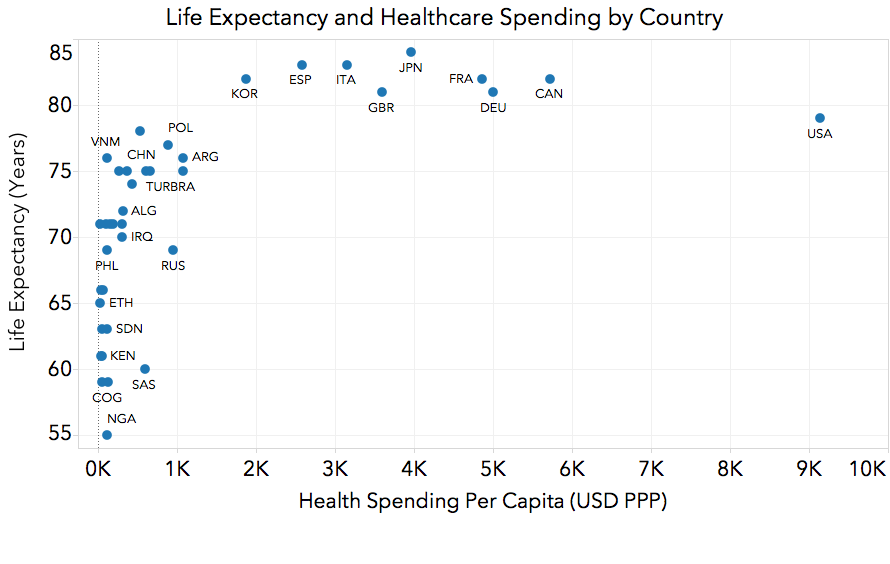A2-KushNijhawan
Contents
Domain of Interest
Healthcare Around the World
First Question
Which countries spend the most and least on healthcare for it's citizens?
Fitness of Data
The data fit to answer my questions because it is from a reliable source, the World Health Organization. Also, the data has all the information I need to answer my initial question.
Process 1
I first got the health insure per capita spending data for every country from the World Health Organization. I have this information for many years for most countries starting at about 1995. I first simplified this data by only focusing in on the most recent year of data – 2013. I then further simplified my data by only focusing on the top 40 countries in the world by population.
Visualization 1
Answer to Initial Question
It's immediately clear that the U.S spends the most per capita on healthcare compared to other countries around the globe. Also, it appears that most countries in Asia and Africa spend a relatively low amount of money per capita on healthcare for its citizens. An exception to this general rule of thumb was Japan. European countries tend to be in the middle of the pack in terms of per capita healthcare spending. Now that I knew that the U.S spent the most money by far, I wanted to see if we were getting results for this high cost. Did our high healthcare spending result in a higher life expectancy? This led to my second question.
Second Question
Which countries have high life expectancies, while still keeping per capita healthcare costs at low or reasonable levels?
Process 2
I added the life expectancy information for each country to my data set and visualization to help me answer my second question. This information also came from the World Health Organization, a highly credible and reliable source.
Visualization 2
Answer to Second Question
The visualization immediately shows that the United States spends the most money on healthcare by far – but the life expectancy is lower than countries that spend considerably less. For example, Japan has the #1 life expectancy in the world at 84 years, but spends half that than the U.S per capita on healthcare. Other countries that spend far less than the U.S – but enjoy a higher life expectancy include Korea, Spain, Italy, Great Britain, France, Germany, and Canada.
I used position to encode the life expectancy information and the healthcare per capita spending information. I picked position because it was the highest ranking encoding according to Mackinlay.
Evolving Questions
- What characteristics do the healthcare systems of these countries share?
- Is there anything that the United States can learn from other countries to reduce its high healthcare spending while still maintaining a high level of care for its citizens?
- What characteristics do the healthcare systems of countries with low life expectancies share?
Final Process
To help me answer these additional questions, I added the healthcare system information for each country. All of this information was according to the World Health Organization, a highly reliable and credible source.
The most difficult piece of information to gather was the healthcare system type for each country. This was because there was a few different ways healthcare systems around the world were categorized. In the end, I decided to go with the Single Payer, Two-Tier, Insurance Mandate, and Out of Pocket categorization. Though not completely easy to understand, this categorization was the most easy to understand. I wanted to minimize the cognitive load of my visualization as much as possible – which is why I did not include a caption that stated the healthcare system descriptions.
Here is a brief description of each healthcare system. (Source: World Health Organization)
- Single Payer: The government provides insurance for all residents (or citizens) and pays all health care expenses except for co-pays and coinsurance. Providers may be public, private, or a combination of both.
- Two Tier: The government provides or mandates catastrophic or minimum insurance coverage for all residents (or citizens), while allowing the purchase of additional voluntary insurance or fee-for service care when desired.
- Insurance Mandate: The government mandates that all citizens purchase insurance, whether from private, public, or non-profit insurers.
- Out of Pocket: Individuals on an add-needed basis pay healthcare costs. Generally the poor and not taken care of in the system.
I picked color to encode the healthcare system type for each country. Healthcare system is a nominal variable, and color is very good for nominal variables. Moreover, according to Mackinlay - color is the second best possible way to encode nominal variables. I also personally thought color was easy to understand and get a sense of the healthcare systems around the world.
Final Visualization
Answers to Additional Questions
All of these countries have some form of universal healthcare. Five of the eight countries have a single-payer system, where the government pay for all health expenses of its citizens. Like the U.S, Germany and South Korea do have an insurance mandate – yet their per capita costs are significantly lower than the United States. The reason for this will take more research beyond what this visualization can show. However, it is clear that the U.S may want to consider a single-payer healthcare model, since it is a proven solution for most of the countries with “high” life expectancies.
Furthermore, the vast majority of countries with low life expectancies have the Out of Pocket Model for healthcare. In this system, the rich get medical care – while the poor suffer and die. Thus, it really isn’t a surprise that the life expectancies in these countries are lower. These countries should take steps towards universal healthcare to give its citizens a better chance of living a longer and healthier life.


